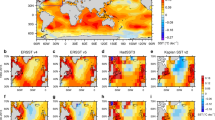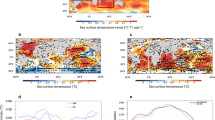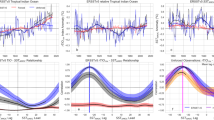Abstract
The slowdown of the Atlantic meridional overturning circulation (AMOC)1,2,3 and the accelerated warming of the tropical Indian Ocean (TIO)4,5,6 are two robust features projected for anthropogenic greenhouse warming, affecting both regional and global climates7,8. Here we use coupled climate simulations to investigate a previously overlooked link between the two phenomena. We demonstrate that TIO warming reduces rainfall over the tropical Atlantic by strengthening the Walker circulation and increasing atmospheric vertical stability. The resultant ocean salinity increase intensifies the AMOC as salinity anomalies are advected to northern high latitudes. In addition, TIO warming enhances westerly winds over the subpolar North Atlantic, which helps to maintain the stronger AMOC. A TIO warming of 0.1 °C above the mean warming of tropical oceans intensifies the AMOC by ~1 Sv, leading to a stronger interhemispheric asymmetry and a northward shifted ITCZ. Thus, TIO warming could delay the AMOC weakening under greenhouse warming. Indeed, we find that the AMOC weakens more strongly or completely collapses if we suppress TIO warming under the doubled and quadrupled CO2 scenarios. Simulations replicating the observed tropical ocean warming further confirm this TIO–AMOC link, suggesting that the observed TIO warming might be already playing a role in sustaining the AMOC.
This is a preview of subscription content, access via your institution
Access options
Access Nature and 54 other Nature Portfolio journals
Get Nature+, our best-value online-access subscription
$29.99 / 30 days
cancel any time
Subscribe to this journal
Receive 12 print issues and online access
$209.00 per year
only $17.42 per issue
Buy this article
- Purchase on Springer Link
- Instant access to full article PDF
Prices may be subject to local taxes which are calculated during checkout




Similar content being viewed by others
Data availability
The NOAA ERSST v4 data set is available at http://www.esrl.noaa.gov/psd/data. The data that support the findings of this study are available from the corresponding author upon request.
Code availability
We used the NCAR Command Language (NCL)40 for all the analyses and figures in this study, which is available from https://doi.org/10.5065/D6WD3XH5.
References
Gregory, J. M. et al. A model intercomparison of changes in the atlantic thermohaline circulation in response to increasing atmospheric CO2 concentration. Geophys. Res. Lett. 32, L12703 (2005).
Cheng, W., Chiang, J. C. & Zhang, D. Atlantic meridional overturning circulation (AMOC) in CMIP5 models: RCP and historical simulations. J. Clim. 26, 7187–7197 (2013).
Rahmstorf, S. et al. Exceptional twentieth-century slowdown in Atlantic Ocean overturning circulation. Nat. Clim. Change 5, 475–480 (2015).
Du, Y. & Xie, S. P. Role of atmospheric adjustments in the tropical Indian Ocean warming during the 20th century in climate models. Geophys. Res. Lett. 35,, L08712 (2008).
Roxy, M. K., Ritika, K., Terray, P. & Masson, S. The curious case of Indian Ocean warming. J. Clim. 27, 8501–8509 (2014).
Dong, L. & Zhou, T. The Indian Ocean sea surface temperature warming simulated by CMIP5 models during the twentieth century: Competing forcing roles of GHGs and anthropogenic aerosols. J. Clim. 27, 3348–3362 (2014).
Sutton, R. T. & Hodson, D. L. Atlantic Ocean forcing of North American and European summer climate. Science 309, 115–118 (2005).
Han, W. et al. Indian Ocean decadal variability: a review. Bull. Am. Meteorol. Soc. 95, 1679–1703 (2014).
Trenberth, K. E. et al. Progress during TOGA in understanding and modeling global teleconnections associated with tropical sea surface temperatures. J. Geophys. Res. Oceans 103, 14291–14324 (1998).
Chiang, J. C. & Sobel, A. H. Tropical tropospheric temperature variations caused by ENSO and their influence on the remote tropical climate. J. Clim. 15, 2616–2631 (2002).
Xie, S. P. et al. Indian Ocean capacitor effect on Indo–Western Pacific climate during the summer following El Niño. J. Clim. 22, 730–747 (2009).
Di Lorenzo, E. et al. Central Pacific El Niño and decadal climate change in the North Pacific Ocean. Nat. Geosci. 3, 762–765 (2010).
Zhang, R. & Delworth, T. L. Impact of the Atlantic multidecadal oscillation on North Pacific climate variability. Geophys. Res. Lett. 34, L23708 (2007).
Lee, S. K. et al. Pacific origin of the abrupt increase in Indian Ocean heat content during the warming hiatus. Nat. Geosci. 8, 445–449 (2015).
Abish, B., Cherchi, A. & Ratna, S. B. ENSO and the recent warming of the Indian Ocean. Int. J. Climatol. 38, 203–214 (2018).
Hoerling, M. P., Hurrell, J. W. & Xu, T. Tropical origins for recent North Atlantic climate change. Science 292, 90–92 (2001).
Cherchi, A. et al. The influence of tropical Indian Ocean SST on the Indian summer monsoon. J. Clim. 20, 3083–3105 (2007).
Cai, W. et al. Pantropical climate interactions. Science 363, eaav4236 (2019).
Xie, S. P. & Philander, S. G. H. A coupled ocean–atmosphere model of relevance to the ITCZ in the eastern Pacific. Tellus A Dyn. Meteorol. Oceanogr. 46, 340–350 (1994).
Stommel, H. Thermohaline convection with two stable regimes of flow. Tellus 13, 224–230 (1961).
Eden, C. & Jung, T. North Atlantic interdecadal variability: Oceanic response to the North Atlantic oscillation (1865–1997). J. Clim. 14, 676–691 (2001).
Delworth, T. L. et al. The North Atlantic oscillation as a driver of rapid climate change in the Northern Hemisphere. Nat. Geosci. 9, 509–512 (2016).
Frierson, D. M. et al. Contribution of ocean overturning circulation to tropical rainfall peak in the Northern Hemisphere. Nat. Geosci. 6, 940–944 (2013).
Kang, S. M., Held, I. M., Frierson, D. M. & Zhao, M. The response of the ITCZ to extratropical thermal forcing: Idealized slab-ocean experiments with a GCM. J. Clim. 21, 3521–3532 (2008).
Schneider, T., Bischoff, T. & Haug, G. H. Migrations and dynamics of the intertropical convergence zone. Nature 513, 45–53 (2014).
Bakker, P. et al. Fate of the Atlantic meridional overturning circulation: strong decline under continued warming and Greenland melting. Geophys. Res. Lett. 43, 12252–12260 (2016).
Sévellec, F., Fedorov, A. V. & Liu, W. Arctic sea-ice decline weakens the Atlantic meridional overturning circulation. Nat. Clim. Change 7, 604–610 (2017).
Liu, W., Xie, S. P., Liu, Z. & Zhu, J. Overlooked possibility of a collapsed Atlantic meridional overturning circulation in warming climate. Sci. Adv. 3, e1601666 (2017).
Durack, P. J. & Wijffels, S. E. Fifty-year trends in global ocean salinities and their relationship to broad-scale warming. J. Clim. 23, 4342–4362 (2010).
Smeed, D. A. et al. The North Atlantic Ocean is in a state of reduced overturning. Geophys. Res. Lett. 45, 1527–1533 (2018).
Caesar, L., Rahmstorf, S., Robinson, A., Feulner, G. & Saba, V. Observed fingerprint of a weakening Atlantic Ocean overturning circulation. Nature 556, 191 (2018).
Delworth, T. L. & Dixon, K. W. Have anthropogenic aerosols delayed a greenhouse gas‐induced weakening of the North Atlantic thermohaline circulation? Geophys. Res. Lett. 33, L02606 (2006).
Shi, J. R., Xie, S. P. & Talley, L. D. Evolving relative importance of the Southern Ocean and North Atlantic in anthropogenic ocean heat uptake. J. Clim. 31, 7459–7479 (2018).
Burls, N. J., Muir, L., Vincent, E. M. & Fedorov, A. Extra-tropical origin of equatorial Pacific cold bias in climate models with links to cloud albedo. Clim. Dyn. 49, 2093–2113 (2017).
Wang, C., Zhang, L., Lee, S. K., Wu, L. & Mechoso, C. R. A global perspective on CMIP5 climate model biases. Nat. Clim. Change 4, 201–205 (2014).
Hansen, J., Ruedy, R., Sato, M. & Lo, K. Global surface temperature change. Rev. Geophys. 48, RG4004 (2010).
Gent, P. R. et al. The community climate system model version 4. J. Clim. 24, 4973–4991 (2011).
Karspeck, A. R. et al. Comparison of the Atlantic meridional overturning circulation between 1960 and 2007 in six ocean reanalysis products. Clim. Dyn. 49, 957–982 (2017).
Xie, S. P. et al. Global warming pattern formation: sea surface temperature and rainfall. J. Clim. 23, 966–986 (2010).
NCAR Command Language v.6.6.2 (UCAR/NCAR/CISL/TDD, 2019); https://doi.org/10.5065/D6WD3XH5
Acknowledgements
A.V.F. was supported by grants from NSF (OCE-1756682, OPP-1741847), the ARCHANGE project of the “Make our planet great again” programme (CNRS, France) and the Guggenheim fellowship. S.H. was supported by the Scripps Institutional Postdoctoral Fellowship Program. We also acknowledge computational support from the NSF/NCAR Yellowstone/Cheyenne Supercomputing Center.
Author information
Authors and Affiliations
Contributions
S.H. conceived the study, conducted the numerical simulations, performed the data analysis and led the writing of the manuscript. S.H. and A.V.F. together interpreted and explained the results and edited the manuscript.
Corresponding author
Ethics declarations
Competing interests
The authors declare no competing interests.
Additional information
Peer review information: Nature Climate Change thanks Claudia Frauen, Changhyun Yoo and the other, anonymous, reviewer(s) for their contribution to the peer review of this work.
Publisher’s note: Springer Nature remains neutral with regard to jurisdictional claims in published maps and institutional affiliations.
Supplementary information
Supplementary Information
Supplementary Figs. 1–17.
Rights and permissions
About this article
Cite this article
Hu, S., Fedorov, A.V. Indian Ocean warming can strengthen the Atlantic meridional overturning circulation. Nat. Clim. Chang. 9, 747–751 (2019). https://doi.org/10.1038/s41558-019-0566-x
Received:
Accepted:
Published:
Issue Date:
DOI: https://doi.org/10.1038/s41558-019-0566-x
This article is cited by
-
Northeast Pacific warm blobs sustained via extratropical atmospheric teleconnections
Nature Communications (2024)
-
Future Indian Ocean warming patterns
Nature Communications (2023)
-
Tropical Atlantic multidecadal variability is dominated by external forcing
Nature (2023)
-
Pantropical Indo-Atlantic temperature gradient modulates multi-decadal AMOC variability in models and observations
npj Climate and Atmospheric Science (2023)
-
Critical role of biomass burning aerosols in enhanced historical Indian Ocean warming
Nature Communications (2023)



